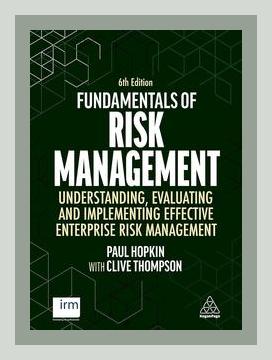Finance and AccountingRisk Management
**
Introduction
Paul Hopkin’s book, “Fundamentals of Risk Management: Understanding, Evaluating and Implementing Effective Risk Management,” is a comprehensive guide to understanding and implementing effective risk management frameworks in various organizations. The book is divided into several key sections, each addressing different aspects of risk management. This summary encapsulates the main points of the book, providing concrete examples and actionable steps for implementing effective risk management strategies.
1. Understanding Risk Management
Hopkin introduces the concept of risk management as a critical function in organizations. He emphasizes that risk management is not solely about minimizing negative outcomes but also about seizing opportunities that risks present.
Actionable Step:
Define the scope of risk management in your organization.
Example: A manufacturing company can identify both the risk of machinery breakdown (negative) and the opportunity of investing in new technology that can increase production efficiency (positive).
2. The Risk Management Process
The book outlines a systematic risk management process, composed of:
– Identification
– Assessment
– Mitigation
– Monitoring
Actionable Step:
Establish a risk management team to oversee these stages.
Example: A healthcare organization can form a committee consisting of doctors, nurses, and administrative staff to identify potential risks, like patient data breaches and develop strategies to mitigate these risks.
3. Risk Identification
Hopkin stresses the importance of identifying all possible risks. He advocates the use of tools such as SWOT analysis, brainstorming sessions, and risk registers.
Actionable Step:
Conduct regular risk identification workshops.
Example: In an IT company, hold bi-monthly meetings where employees can report any new risks they foresee, such as software bugs or cybersecurity threats.
4. Risk Assessment
Assessment involves evaluating the likelihood and impact of identified risks. Techniques such as qualitative and quantitative analysis are discussed.
Actionable Step:
Utilize risk assessment matrices to prioritize risks.
Example: A retail business can create a risk matrix plotting likelihood against impact to prioritize risks such as supply chain disruptions or data theft.
5. Risk Mitigation
Mitigation strategies are necessary to manage identified risks. Hopkin discusses various methods like risk avoidance, reduction, sharing, and acceptance.
Actionable Step:
Develop a risk mitigation plan based on the prioritized risks.
Example: A construction company can reduce the risk of site accidents by investing in safety training and equipment.
6. Risk Monitoring and Review
Regular monitoring and reviewing of risks ensure that risk management strategies remain effective and that new risks are identified promptly.
Actionable Step:
Implement continuous risk monitoring systems.
Example: An airline can adopt real-time monitoring systems to track weather conditions and air traffic, adjusting flight operations accordingly.
7. Risk Communication
Effective communication is paramount in risk management. Transparency and clarity in communicating risks ensure all stakeholders are aware and prepared.
Actionable Step:
Create clear channels for risk communication.
Example: A financial institution can design a risk communication protocol where risk information is shared through monthly reports and regular briefings.
8. The Role of Risk Culture
Hopkin highlights the importance of embedding a risk-aware culture within an organization. This involves educating employees about risk management and encouraging a proactive approach to identifying and addressing risks.
Actionable Step:
Foster a risk-aware culture through training and awareness programs.
Example: A tech company can incorporate risk management modules in their onboarding process to ensure new employees are aware of the company’s risk policies.
9. Risk Management Frameworks and Standards
The book reviews various risk management frameworks, such as ISO 31000, COSO ERM, and the Casualty Actuarial Society guidelines, stressing their importance in establishing a structured risk management approach.
Actionable Step:
Adopt a recognized risk management framework.
Example: A logistics company can adopt ISO 31000 to structure their risk management efforts, ensuring consistency and comprehensiveness.
10. Risk Management and Strategic Planning
Hopkin links risk management with strategic planning, ensuring that risk considerations are integral to an organization’s strategic objectives.
Actionable Step:
Integrate risk management into strategic planning sessions.
Example: During annual strategic planning, a telecom company can include risk assessments and mitigation strategies for market competition and technological changes.
11. Risk Transfer and Insurance
The book explains the importance of transferring certain risks through mechanisms like insurance to mitigate potential financial losses.
Actionable Step:
Evaluate and obtain appropriate insurance coverages.
Example: A retail chain can secure business interruption insurance to cover losses from unforeseen events such as natural disasters.
12. Crisis Management and Business Continuity
Hopkin discusses the necessity of preparedness for crises through business continuity planning and crisis management strategies.
Actionable Step:
Develop and regularly update a business continuity plan.
Example: An IT service provider can develop a comprehensive disaster recovery plan to ensure service continuity in case of cyber incidents.
13. Legal and Regulatory Considerations
Organizations must be aware of legal and regulatory requirements related to risk management to ensure compliance and avoid penalties.
Actionable Step:
Stay updated with relevant legal and regulatory requirements.
Example: A manufacturing company must comply with occupational health and safety regulations to avoid legal liabilities and ensure workplace safety.
14. Risk Management in Different Sectors
Hopkin examines how risk management applies differently across various sectors such as finance, healthcare, manufacturing, and public sector organizations.
Actionable Step:
Tailor risk management approaches to sector-specific risks.
Example: A pharmaceutical company should focus on risks related to drug development and regulatory approvals.
15. The Future of Risk Management
Finally, Hopkin considers future trends in risk management, including the increasing importance of technology and data analytics, and the evolving landscape of global risks.
Actionable Step:
Invest in technology and data analytics for advanced risk management.
Example: A financial services firm can implement predictive analytics to better anticipate market risks and economic downturns.
Conclusion
Paul Hopkin’s “Fundamentals of Risk Management” offers a critical, in-depth look at the multifaceted nature of risk management and its essential role in strategic and operational decision-making. By following the actionable steps derived from each key point, individuals and organizations can not only protect themselves from potential negative impacts but also leverage risks to uncover new opportunities and drive success.
